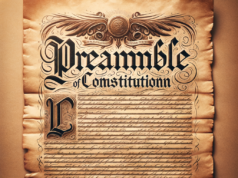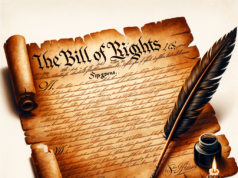Table of Contents

The Articles of Confederation
The Articles of Confederation, America’s first constitution, was ratified in 1781, during the Revolutionary War. The Articles were an attempt to unite the 13 colonies under a single federal government, and they remained in effect until the ratification of the current United States Constitution in 1789.
Structure of Government
Under the Articles of Confederation, the federal government was weak and had limited powers. The government consisted of a single branch, the Congress, which was made up of delegates from each state. Each state, regardless of population or size, had one vote in Congress.
Powers of Government
The federal government was given some powers under the Articles of Confederation. These included the power to declare war, make peace, sign treaties, make alliances, and appoint senior military officers. However, the government did not have the power to tax or regulate commerce between the states, making it difficult to fund the war effort.
Weaknesses of the Articles of Confederation
The Articles of Confederation were ultimately deemed insufficient for governing the new nation. One of the main weaknesses was the lack of a strong central government. The government had no power to collect taxes, and therefore could not fund its own operations or pay off the war debt. Additionally, the government had no power to regulate commerce between the states, which led to economic chaos and disputes between states.
Replacement by the U.S. Constitution
The weaknesses of the Articles of Confederation became increasingly apparent, and in 1787, a group of delegates met in Philadelphia to draft a new constitution. The result was the U.S. Constitution, which established a stronger federal government and addressed many of the weaknesses of the Articles of Confederation.
In conclusion, the Articles of Confederation served as America’s first attempt at a federal government, but ultimately proved to be insufficient for the needs of the new nation. The shortcomings of the Articles of Confederation led to the drafting of the U.S. Constitution, which established a stronger federal government and has remained the foundation of American government to this day.
Background
The Articles of Confederation was the first implemented national policy after the establishment of the United States of America, as a result of their independence from England. The citizens of the new nation were scarred as a result of their existence under the monarchy of King George II.
As such, the authors of the Articles of Confederation opted to remove all control that a governing body could potentially exercise over the individual 13 states.
Though the central government could control the military, postal service, currency, and foreign policy, it was powerless to influence any of the actions of the sovereign 13 states. However, the dysfunctions of the Articles of Confederation made way for the ratification of the Constitution, which successfully fused the presence of a central government with an innate focus on the interest of its citizens.
Inherent Weaknesses
Amongst the critics of the Articles of Confederation, few were more vocal than the Federalists, a political group headed by Alexander Hamilton and James Madison, passionate about uniting the 13 states rather than granting them sovereignty. The Federalists warned that without the presence of a central government to create and enforce laws on a national level, unity could not exist. As a result of the lack of power that the central government had over the 13 states, it could only request payment from the respective states, as well as merely suggest that laws be followed.
The Federalists illustrated a paradox that plagued the Articles of Confederation: Though the central government could establish laws, they were unable to enforce them. As a result, each State was granted sovereignty. This proved to add a dangerous dynamic to the newly-formed nation – it was foregoing the autonomy that it had fought to regain.
Lacking Executive Power
The Articles of Confederation were penned in order to prevent a totalitarian government, yet its contents were regarded as both extremist and reactionary by the Federalists. One of the primary criticisms brought forth by the Federalists in regards to the Articles of Confederation was the presumption that its authors had simply exchanged one unsatisfactory situation for another. By disallowing the central government to retain any control over any of the individual 13 states, who at the time considered themselves to be sovereign entities, created a situation in which the existence of any nationalized policy was impossible.
Though the Articles of Confederation allowed the central government control over the military, postal service, and the creation of currency, the states could only be asked to make monetary donations in lieu of mandatory taxation. As a result, the central government found itself in financial disarray as a result of its necessity to create currency without stable financial backing. The Articles of Confederation required that the passing of a new law involve the approval of at least 9 of the 13 states and the establishment of an Amendment required the unanimous approval – this made legislation impossible.
Varying State Governmental Bodies
Without an ability to control, oversee, or regulate the actions of each individual State, the central government could only look on as each of the 13 states both managed and maintained their respective policies. The Articles of Confederation forbid the central government to exercise any control over the 13 states. As a result, each State was able to establish individual spending policies and trade regulations. In addition, each State was given the right to choose whether or not they wished to uphold certain laws.
The Articles of Confederation also allowed each State to establish individual trade regulations and tariffs, which allowed for excessive and sometimes unfair commercial dealings.
The establishment of a nationalized foreign policy became impossible because each of the 13 states maintained 13 different foreign policies, which affected not only diplomacy but foreign relations, as well. The instability of the United States of America’s foreign policy coupled with a collapsing military service proved to be one of the many flaws in the Articles of Confederation, which were vocalized by the Federalists.

























